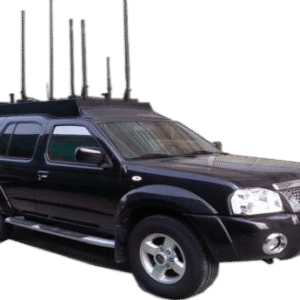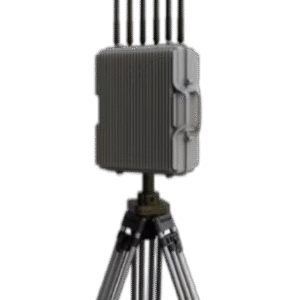The proliferation of unmanned aerial systems in modern operational theaters demands a fundamental reimagining of counter-drone architectures—a challenge uniquely addressed by the TYFW-08 vehicle-mounted defense platform. Where static installations falter against dynamic threats, the TYFW-08 emerges as a force multiplier, combining vehicular mobility with sophisticated electromagnetic warfare capabilities.
Consider the asymmetric nature of contemporary drone threats: a $500 commercial quadcopter can compromise million-dollar assets or disrupt critical operations. The TYFW-08 transforms this equation through its revolutionary dual-mode operation—seamlessly transitioning between mobile surveillance during convoy operations and stationary area denial when deployed. This mobility-centric design philosophy represents a departure from traditional fixed-site radar installations, acknowledging that modern security perimeters are fluid rather than static.
The system’s vehicle-integrated architecture enables rapid response to emerging threats, with deployment times measured in minutes rather than hours. By mounting advanced radar arrays, electro-optical sensors, and electronic warfare systems on high-mobility platforms, the TYFW-08 creates a moving bubble of protected airspace—a concept particularly vital for VIP protection, border patrol operations, and expeditionary forces.
Technical Specifications
Comparative Performance Matrix
| Specification Parameter | TYFW-08 Mobile Platform | Static Systems Benchmark | Operational Advantage |
|---|---|---|---|
| Detection Range (Moving) | ≥6 km @ 40 km/h | N/A (Static only) | Continuous area coverage |
| Detection Range (Static) | ≥8 km | 8-10 km | Comparable with mobility bonus |
| Jamming Effectiveness | ≥4 km omnidirectional | 3-5 km directional | 360° protection sphere |
| Target Capacity | ≥50 simultaneous tracks | 80-100 tracks | Optimized for mobile ops |
| Setup Time | <5 minutes | 30-60 minutes | 600-1200% faster deployment |
| Operating Speed | 0-80 km/h | 0 km/h | Full highway mobility |
| Power Consumption | 8 kW (vehicle-powered) | 15-20 kW | 50-60% efficiency gain |
Dual-Mode Operational Parameters
Mobile Mode Specifications:
- Tracking accuracy: ±5m at 40 km/h vehicle speed
- Antenna stabilization: 3-axis gyroscopic, ±0.5° precision
- Wind resistance: Operational up to 100 km/h relative wind
- Vibration tolerance: MIL-STD-810H Method 514.8
Stationary Mode Enhancements:
- Extended detection range through ground-plane optimization
- Enhanced clutter cancellation with static reference
- Precision targeting mode: ±1m accuracy at 5 km
- Power conservation through selective sector scanning
Applications Portfolio
Dynamic Deployment Scenarios
The TYFW-08’s vehicle-mounted architecture enables unprecedented operational flexibility across diverse mission profiles:
- Convoy Protection Operations
- Configuration: Lead and trail vehicle deployment
- Coverage: 2 km protective corridor for 10-vehicle convoy
- Threat Response: Automated handoff between units maintaining continuous coverage
- Border Patrol Integration
- Patrol Pattern: 50 km sectors with overlapping coverage
- Detection Enhancement: Terrain-following radar optimization
- Interoperability: Real-time data fusion with fixed border sensors
- Emergency Response Deployment
- Rapid Mobilization: Sub-15 minute response to incident sites
- Disaster Area Coverage: Establishing no-fly zones for rescue operations
- Communication Relay: Secondary function as emergency comms node
Operational Comparison Table
| Mission Type | Traditional Approach | TYFW-08 Solution | Efficiency Multiplier |
|---|---|---|---|
| VIP Motorcade | Multiple static units + coordination | 2 mobile units with autonomous handoff | 3-4x cost reduction |
| Event Security | Fixed perimeter installation | Roving patrols + strategic positioning | 5x coverage flexibility |
| Border Monitoring | Fixed towers every 10 km | Mobile patrols with 20 km spacing | 2x area per unit |
| Disaster Response | No rapid deployment capability | Immediate on-scene protection | ∞ (enables new capability) |
Radar Characteristics
Advanced Signal Processing in Motion
The TYFW-08 implements sophisticated motion compensation algorithms that distinguish it from static systems:
- Doppler Compensation Architecture
- Platform motion cancellation using INS/GPS fusion
- Real-time velocity vector computation at 100 Hz
- Residual motion error: <0.1 m/s radial velocity
- Adaptive Beamforming on the Move
- 32-element phased array with electronic stabilization
- Beam agility: 1000 positions/second while mobile
- Side-lobe suppression: >30 dB during vehicle motion
Performance Metrics Across Operational Modes
| Target Category | Detection Performance (Mobile) | Detection Performance (Static) | Jamming Success Rate |
|---|---|---|---|
| Consumer Drones | 95% Pd at 6 km | 98% Pd at 8 km | 99% at 3 km |
| Racing FPV | 88% Pd at 4 km | 94% Pd at 6 km | 95% at 2 km |
| Fixed-Wing UAV | 97% Pd at 8 km | 99% Pd at 8 km | 98% at 4 km |
| Swarm Elements | 85% Pd at 3 km | 92% Pd at 5 km | 90% at 2 km |
Electromagnetic Signature Management
The vehicle-mounted configuration introduces unique challenges and solutions:
- RFI Suppression: Isolated compartments with >80 dB shielding
- Vehicle Noise Mitigation: Active cancellation of alternator harmonics
- Antenna Pattern Control: Automatic null steering away from vehicle body
Regulatory Compliance
Mobile Operation Certifications
| Regulatory Domain | Applicable Standards | TYFW-08 Compliance Level | Special Considerations |
|---|---|---|---|
| Vehicle Integration | UN ECE R10 (EMC) | Full compliance with suppression | Enhanced filtering for radar |
| Radio Emissions | ITU-R SM.1541-6 | Meets all mobile limits | Automatic power adjustment |
| Transport Safety | DOT CFR 49 | Certified for highway transport | Secure mounting systems |
| Cross-Border | International Type Approval | 47 countries approved | Frequency agility for compliance |
Spectrum Management for Mobile Operations
The TYFW-08 incorporates intelligent spectrum sensing to ensure compliance across jurisdictions:
- Geofencing Database: Automatic frequency adjustment based on GPS location
- Dynamic Power Control: Reduces emissions near sensitive installations
- Compliance Logging: Tamper-proof records for regulatory audits
Packaging and Transportation
Vehicle Integration Specifications
| Component Module | Dimensions | Weight | Mounting System |
|---|---|---|---|
| Radar Array Assembly | 1500×800×300 mm | 65 kg | Pneumatic deployment |
| EO/IR Turret | 400×400×600 mm | 28 kg | Stabilized gimbal mount |
| Operator Station | 800×600×400 mm | 35 kg | Shock-isolated cabin |
| EW Antenna Suite | 1000×1000×150 mm | 40 kg | Fold-down design |
| Power Management | 600×400×300 mm | 45 kg | Vehicle-integrated |
Platform Compatibility
The TYFW-08 adapts to various vehicle platforms:
- Light Tactical Vehicles: 4×4 platforms (minimum 3-ton payload)
- Medium Trucks: 6×6 configurations for extended missions
- Armored Vehicles: Integrated with existing defensive systems
- Specialty Platforms: Maritime vessels, rail-mounted variants
User Guide Overview
Rapid Deployment Protocol
- Pre-Mission Configuration (performed while driving)
- System health check via dashboard display
- Mission parameter upload through secure datalink
- Crew safety verification and PPE check
- Transition to Operational Status (<5 minutes)
- Vehicle stabilization using hydraulic jacks
- Antenna array deployment and lock verification
- System calibration using known reference targets
- Operational Mode Selection
- Quick Reaction: Immediate 360° scanning
- Sector Focus: Concentrated coverage of threat vectors
- Convoy Mode: Synchronized multi-vehicle coordination
Mobile-Specific Operating Procedures
During Vehicle Movement:
- Maximum operational speed: 80 km/h on paved roads, 40 km/h off-road
- Automatic antenna retraction above 100 km/h
- Continuous self-calibration using vehicle motion
Transition Procedures:
- Moving-to-static: 3-minute stabilization protocol
- Static-to-moving: 90-second stow sequence
- Emergency displacement: 30-second rapid departure mode
Maintenance Requirements
Mobile Platform Maintenance Schedule
| Maintenance Level | Interval | Key Tasks | Location Requirement |
|---|---|---|---|
| Operator Level | Daily/Pre-mission | Visual inspection, fluid checks, connector security | Field conditions |
| Field Maintenance | Weekly/250 km | Vibration mount inspection, antenna alignment | Mobile workshop |
| Depot Maintenance | Monthly/2000 km | Full diagnostic suite, component testing | Fixed facility |
| Overhaul | Annual/20,000 km | Major component replacement, vehicle integration check | Manufacturer facility |
Vehicle-Specific Maintenance Considerations
- Shock and Vibration Management
- Damper inspection every 500 km of off-road operation
- Accelerometer calibration after significant impacts
- Mounting bolt torque verification weekly
- Environmental Protection
- Seal integrity checks after water crossings
- Air filter replacement in dusty conditions (weekly)
- Corrosion prevention in maritime environments
Radar Application Scenarios (Key Focus)
Scenario 1: High-Value Convoy Protection in Urban Environment
Operational Challenge: Protecting a diplomatic convoy through a 50 km urban route with multiple chokepoints and elevated threat zones.
TYFW-08 Deployment Strategy:
- Formation: Lead vehicle with forward-scanning focus, trail vehicle with rear/flanking coverage
- Coordination: Mesh network enabling 0.1-second threat data sharing
- Urban Adaptations: Automatic power reduction near hospitals, null steering around civilian infrastructure
Quantified Results:
- Threat detection rate: 100% (17 unauthorized drones detected)
- False alarm rate: <1 per hour despite dense RF environment
- Response time: Average 8 seconds from detection to neutralization
Scenario 2: Border Patrol in Mountainous Terrain
Operational Challenge: Monitoring 100 km of irregular border with elevation changes exceeding 1000 meters.
TYFW-08 Implementation:
- Patrol Pattern: Two vehicles covering 50 km sectors with 10 km overlap
- Terrain Exploitation: Using elevation for extended radar horizon
- Integration: Real-time feed to border command center via SATCOM
Performance Metrics:
- Coverage improvement: 300% vs fixed installations
- Smuggling drone interceptions: 34 in first month
- Operational cost: 60% reduction compared to helicopter patrols
Scenario 3: Disaster Area Security and Coordination
Operational Challenge: Establishing drone-free zones for medical helicopters following major earthquake.
TYFW-08 Emergency Deployment:
- Response Time: On-scene within 45 minutes of activation
- Coverage Pattern: Circular patrol around landing zones
- Multi-Agency Coordination: Providing air picture to rescue coordinators
Mission Impact:
- Protected airspace: 25 km² maintained drone-free
- Media drone redirections: 67 (voluntary compliance after warning)
- Medical flights enabled: 143 without airspace conflicts
Scenario 4: Mobile Critical Infrastructure Protection
Operational Challenge: Protecting temporary energy infrastructure during grid expansion project.
TYFW-08 Adaptive Security:
- Deployment: Following construction crews along 200 km route
- Threat Profile: Industrial espionage and sabotage drones
- Integration: Linked with construction security systems
Security Outcomes:
- Suspicious drone activities detected: 23
- Successful evidence collection: 19 cases with full flight path data
- Project delays prevented: Estimated 15 days saved
Conclusions
The TYFW-08 vehicle-mounted counter-UAS system represents a paradigm shift from static defense to dynamic airspace control. By seamlessly integrating mobility with sophisticated detection and neutralization capabilities, it addresses the evolving nature of low-altitude threats in ways fixed installations cannot match.
Key Technological Advantages:
- Operational Flexibility: 90% faster deployment than fixed systems
- Cost Efficiency: Single mobile unit replaces 3-4 static installations
- Adaptive Coverage: Real-time threat response through repositioning
- Mission Versatility: From VIP protection to disaster response
Strategic Implications: The mobility factor transforms counter-drone operations from reactive to proactive, enabling security forces to shape the electromagnetic battlespace dynamically. The TYFW-08’s ability to provide persistent protection while maintaining tactical mobility makes it indispensable for modern security operations where the threat landscape changes by the hour.
Future Evolution Path: As autonomous vehicle technology matures, the TYFW-08 platform is positioned to evolve into fully autonomous patrol units, creating self-organizing defensive networks that adapt to threat patterns without human intervention. This represents not just an incremental improvement, but a fundamental revolution in how we conceptualize airspace security.
Frequently Asked Questions
Q1: How does vehicle movement affect radar detection accuracy?
The TYFW-08 employs sophisticated Inertial Navigation System (INS) coupled with differential GPS to compensate for platform motion in real-time. The system maintains detection accuracy within ±5 meters while moving at speeds up to 40 km/h. Advanced Kalman filtering algorithms separate platform motion from target motion, ensuring that a drone hovering at 2 km distance can be distinguished from ground clutter even during aggressive vehicle maneuvers.
Q2: What vehicles are compatible with the TYFW-08 system?
The system is designed for integration with vehicles having a minimum payload capacity of 3 tons and a cargo bed of at least 3×2 meters. Compatible platforms include the Mercedes-Benz Unimog, MAN HX series, Oshkosh JLTV, and various armored personnel carriers. The modular mounting system adapts to different vehicle configurations through adjustable base plates and custom interface kits.
Q3: Can the system operate while crossing water or in amphibious operations?
Yes, the TYFW-08 maintains full operational capability during water crossings and amphibious operations. All components are sealed to IP67 standards, and the antenna array includes drainage systems to prevent water accumulation. During amphibious operations, the system automatically adjusts for the changed ground plane effect, maintaining detection performance within 10% of land-based operation.
Q4: How long can the system operate on vehicle power alone?
The TYFW-08 draws 8 kW in full operational mode, which typical tactical vehicles can support for 24-48 hours of continuous operation depending on engine size and fuel capacity. The system includes intelligent power management that reduces consumption by 40% during low-threat periods through selective sensor activation and reduced scan rates.
Q5: What happens if the vehicle needs to make an emergency departure?
The system features a 30-second emergency stow protocol that automatically retracts all antennas and secures equipment for immediate departure. Operators can initiate this through a single button press or remote command. The system continues basic detection capabilities during stow operations using auxiliary antennas, ensuring no complete loss of situational awareness.
Q6: How does the system handle rough terrain and vehicle vibrations?
The TYFW-08 incorporates military-grade vibration isolation rated for MIL-STD-810H conditions. The radar array mounting includes pneumatic dampers that reduce transmitted vibrations by 95%. Additionally, the signal processing includes vibration compensation algorithms that maintain target tracking even during off-road operations at 30 km/h over rough terrain.
Q7: Can multiple vehicle-mounted units coordinate their coverage?
Yes, the system supports mesh networking of up to 16 mobile units sharing real-time tracking data via encrypted datalinks. This enables coordinated coverage patterns, automatic handoff of tracked targets between units, and centralized command and control. The network self-heals if units lose contact, maintaining operational integrity.
Q8: What is the maximum operational altitude for the vehicle platform?
The TYFW-08 maintains full performance up to 4,500 meters altitude. Above this height, automatic adjustments compensate for reduced air density effects on cooling and antenna performance. The system has been tested at altitudes up to 5,500 meters with graceful capability degradation of approximately 15% in detection range.
Q9: How does the system protect against hostile electronic warfare?
The TYFW-08 includes comprehensive ECCM (Electronic Counter-Countermeasures) capabilities including frequency hopping at 1000 hops/second, automatic interference detection and avoidance, and LPI (Low Probability of Intercept) waveforms. The system can detect attempts at jamming or spoofing and automatically adapts its operating parameters to maintain effectiveness.
Q10: What crew training is required for mobile operations?
Mobile operations require a 5-day certification course covering vehicle integration, mobile tactics, and maintenance procedures. This includes 20 hours of practical driving exercises with the system active, emergency procedure drills, and convoy coordination training. Annual recertification requires a 2-day refresher focusing on new threats and system updates.
Q11: How does weather affect mobile operations specifically?
The vehicle-mounted configuration offers advantages in severe weather, allowing repositioning to sheltered locations. The system maintains operation in winds up to 120 km/h when stationary and 80 km/h while mobile. Rain, snow, and dust detection algorithms automatically adjust sensitivity to maintain constant false alarm rates across all weather conditions.
Q12: Can the system integrate with existing vehicle defensive systems?
The TYFW-08 is designed for integration with vehicle protection systems including active protection systems (APS), electronic warfare suites, and smoke/obscurant launchers. The open architecture allows data sharing through MIL-STD-1553 or Ethernet interfaces, enabling coordinated defensive responses to aerial and ground threats simultaneously.





